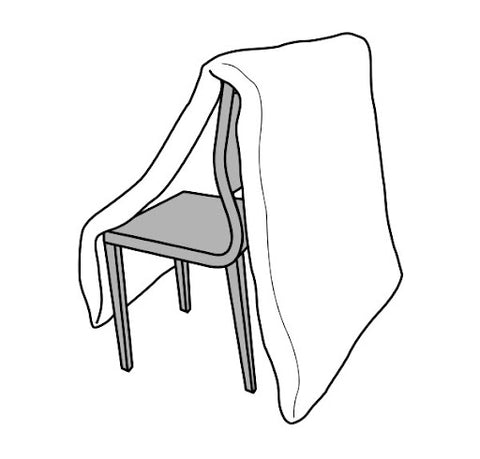The traditional Japanese mattress, the shikifuton, is the foundation of our Japanese Sleep System.
It is made with all-natural cotton and no synthetic materials, while our Japanese organic cotton shikifuton mattress uses 100% organic materials. Because of this, they require a bit more love and care than the traditional Western mattress, but if well cared for, these futons can last for years to come. Here are several things you can do to optimize your shikibuton care routine and get the most life out of your Japanese futon bed.

Sunning Your Shikifuton
What is “Sunning”?
On sunny days in Japan, it is quite common to see shikifutons hanging outside on balconies. This routine is known as sunning. Due to the fact that these futons are made of cotton, an all-natural fiber, they need time in the sun to “breathe”, air out, and fluff the internal fibers. Sunning your futon helps to prevent the growth of mold and mildew by allowing built up moisture to dissipate.
Placing your shikifuton on a tatami mat will greatly improve airflow within the mattress and reduce moisture build-up (as opposed to placing it directly on the floor), but you should still regularly sun your Japanese style futon no matter where you place it.
How to Sun Your Shikibuton
Ideally, a shikifuton bed should be aired outside in direct sunlight. Many people who own (or are interested in owning) a shikifuton may not have a place in or around their home that allows adequate space or sunlight to air out their futon, but there are plenty of ways to get around this issue:
-
The best way to fully ventilate your mattress is by hanging it, but we understand that futons - especially in larger sizes - can be bulky and heavy. Using a railing (such as on a deck, patio, or outdoor stairs), chairs, or even a piece of furniture (like a table) to rest your futon on can help elevate it both indoors or outdoors (see image below).
-
If you can’t place your futon outside anywhere in direct sun, try placing it near a window that receives a lot of natural light. In front of a sliding door, a bay window, or in a sunroom can be excellent indoor places to sun your futon. If weather permits, open the window(s)/door near the futon to allow fresh air to come in contact with it.

While sunning, it is recommended that you hit your futon with a racket in order to release any dust that has accumulated. While you can use a vacuum cleaner to do this, you should be gentle with your futon, so we do recommend using a racket or broom instead. Vacuums, particularly the brush roll function, could tear the futon and may be too unhygienic for use on a mattress.
Please note: Always remove your traditional Japanese futon covers and Shikifuton Protective Cover from the shikifuton mattress prior to sunning it.
How Often Should I Sun My Futon?
There are a lot of variables that go into determining how often you should sun your Japanese floor mattress, such as placement of the bed (if it’s on a tatami mat, carpet, etc.), the climate you live in, how much you sweat while sleeping, how long you’ve owned it, and so on.
In general, we advise sunning your futon as much as possible, at a minimum of 2 times per year. The purpose of sunning is to air out moisture and dust from your mattress, so the less airflow your mattress receives, the more often it should be sunned.
If your futon is placed directly on the floor (especially carpet), you sleep warm, use your futon often, or use it in a humid environment, then we recommend sunning your futon once every 1 or 2 weeks.
If you don’t use your mattress regularly for sleeping, use it on top of a tatami mat or other elevated, ventilated surface, and don’t get very warm in your sleep, then less frequent sunning should be appropriate for your shikifuton.
Sunning should be done for a minimum of approximately 2 hours on each side. Feel free to increase this time if your sunning method does not allow for lots of sun and fresh air, such as any of the aforementioned indoor methods.

Cleaning Your Shikifuton
If you are considering buying a shikifuton, it is highly recommended that you buy a removable cover as well. Our Japanese futon covers function like a fitted sheet does for a spring mattress. Most of these covers are made from 100% cotton fabrics imported from Japan and sewn together here in the USA by our group of talented craftspeople.
Our cotton covers can be machine washed in cold water and preferably line-dried, but can be tumble dried if needed. We also offer a selection of premium, washable silk fabrics that are available across all of our Japanese bedding covers and pillowcases. Please refer to our silk bedding care guide to find detailed washing instructions for these items.
If you have spilled something on your futon and need to clean it or if a pet had an accident, we recommend spot cleaning. Make a mixture of water and detergent and spot clean as necessary. When done, pat the area with rubbing alcohol to sanitize the area and then use a hair dryer to make sure the area is completely dry. Allow the futon to dry completely again before sleeping on it, placing any covers on, or folding/ storing it.
Our Shikifuton Protective Cover is also an effective way to protect your Japanese floor mattress from spills, tears, dirt, and other messes. This specially designed mattress protector simply zips directly over your futon, then your shikibuton covers go over that. The protective cover will not be visible, but you can rest easy knowing that you have an extra layer of protection on your new bed.

Rotating Your Futon
In order to avoid dips and indents in your shikifuton, it is important to rotate and flip it every week or so. This will make sure the cotton stays evenly dispersed throughout and help guarantee a long life for your futon. When you are not using the futon, it is best practice to fold it using the triple-fold method (as pictured above) for storage, or when transporting it. Folding your mattress also helps keep the cotton evenly distributed throughout and allows for convenient transport and storage.
If you have any questions regarding your shikifuton or other J-Life sleep products, please refer to our Japanese Bedding FAQs. You can find our other product care guides here.


13 comments
Recently got the full size futon and am having the hardest time folding it into thirds. Reviews keep mentioning how light it is and easy to fold but I can barely fold mine in half and have it stay.
Any advice?
I live in an apartment where I do not have outside space to air out my mattress. I also live in an area where it is winter five months out of the year. Is there another way that I can air out the mattress? I do plan on folding it up and putting it out of the way every day.
I was just wondering if it’s ok to use a cool air whole room humidifier while I have these futons?
Hi I am considering buying a futon and live in a city apartment. I cannot sun it outside. Can I place it in the sun inside or is that not enough? Thanks
we purchased one of your futons and are very satisfied. We also purchased one of your covers. What I m looking for now is a 100% organic cotton mattress cover, just a flat one piece the lays on top of mattress cover with nothing on the side.